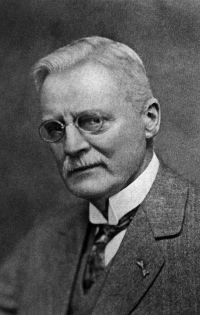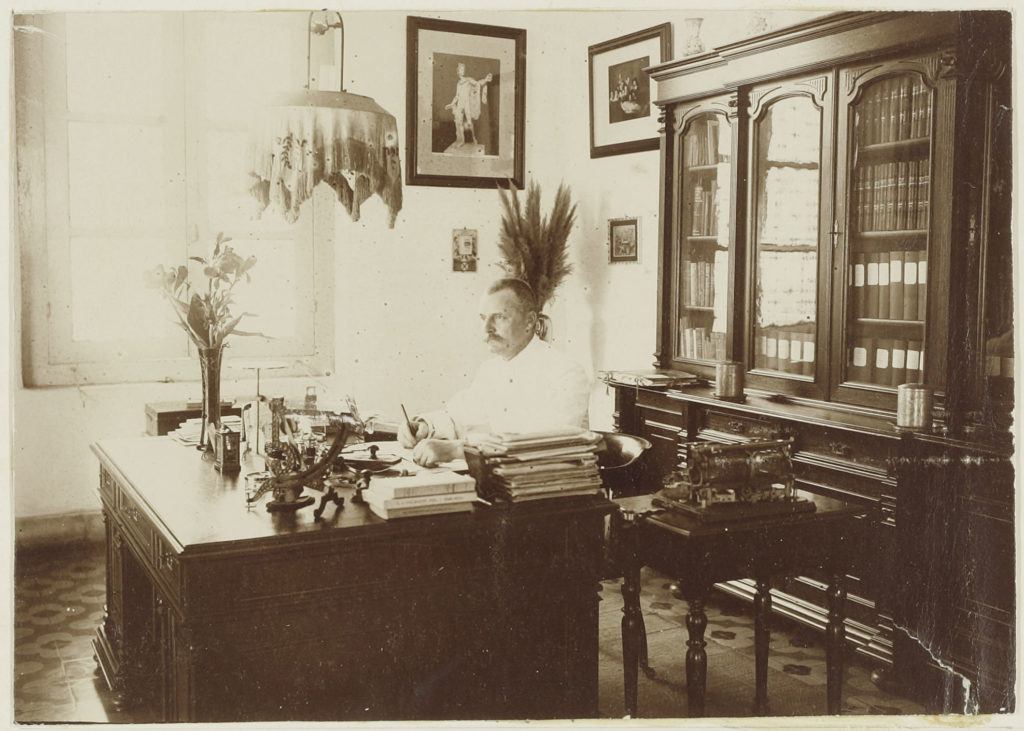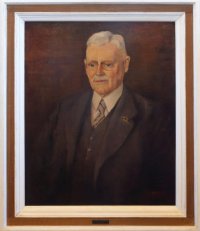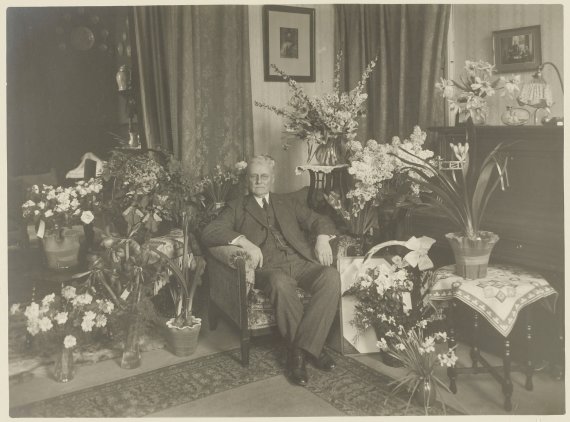photo’s National museum Boerhaave Leiden, WUR archive and Guy Ackermans

Gerrit Grijns during his years as professor at Wageningen.
The name Gerrit Grijns is unlikely to ring a bell with very many people. Which is a pity. Grijns was professor of Animal Physiology at Wageningen from 1921 until he retired (at the age of 70) in 1935. In the academic year 1929-30 he was also rector magnificus for a year, as was customary in those days. But what gives Gerrit Grijns an important place in the annals of science is his contribution to the discovery of vitamins.
To understand that contribution we must go back to the Dutch East Indies, today’s Indonesia, at the end of the 19th century. In the last decade of that century, before Wageningen even existed as a higher education institution, one of the main causes of death in the Dutch colony was beriberi. This disease started with general weakness and exhaustion, leading to numbness in arms and legs and usually ending in death from heart failure. An autopsy revealed degeneration of the nerves. The victims of the disease included many soldiers and prisoners. In fact, the situation in prisons was so acute at one point that three months ‘inside’ was tantamount to a death sentence.

Gerrit Grijns in his director’s office at the Medical Laboratory in Batavia.
Husked rice
In 1886, the Dutch government in Batavia –present-day Jakarta – decided to establish a research facility with the aim of tracking down the cause of beriberi. This was eventually achieved by the Dutch doctor Christiaan Eijkman, who discovered that the disease was caused by eating hulled, white rice. The story of this discovery is too good to keep to ourselves.
His quest for the cause of beriberi set Eijkman on the trail of a bacterial infection. Pasteur had just discovered penicillin and a bacterial infection seemed a promising line of enquiry. Eijkman had also spent a few months working with the German scientist Robert Koch, who discovered the tuberculosis bacillus. He tried to infect rabbits and monkeys with beriberi using blood from soldiers who had died of the disease. Without success. Then he tried the same thing on chickens. This time with success. Within a month all the chickens fell sick, with symptoms that strongly resembled beriberi. Eijkman called the disease polyneuritis gallinarum.
But oddly enough, even the chickens Eijkman had not infected went down with this disease. And the chickens perked up again a few weeks later, just as suddenly as they had fallen ill. Eijkman was faced with a riddle. Until he found out that there had been a change of cook at the military hospital next-door. The previous cook fed leftover cooked white rice to the chickens. The new cook thought that was a waste of precious ‘military’ rice, and the chickens went back on a diet of ordinary, unprocessed rice. The changes of cook coincided precisely with the appearance and disappearance of the disease in the chickens. Eijkman was now on the rice trail. Further research proved convincingly that the lack of husk on rice was the cause of both the chicken disease and beriberi. Both diseases could be treated quite simply with the right diet.
The department of serology at the Medical Laboratory in Batavia.
Disease of deficiency
Eijkman still didn’t know what the nature of this link was, though. He assumed that a decisive role was played by the starch in the rice. He hypothesized that this starch triggered a bacterium in the intestinal tract to produce a toxic substance. And that this process was combatted by a substance in the husk of the rice, dubbed the anti-beriberi factor. As a bacteriologist, he stuck to the infection theory.
This is where Gerrit Grijns comes into the picture. After Eijkman left for the Netherlands for health reasons, Grijns was appointed in 1896 to take over the research in the Medical Laboratory in Batavia. This was a homecoming of sorts: after graduating in medicine at Utrecht, he had already been Eijkman’s assistant in the Dutch East Indies from 1892 to 1894. In his new post, Grijns spent three years conducting a series on nutrition tests on chickens, with the aim of identifying the mystery substance in wholegrain rice.
What came out was that polyneuritis had nothing to do with the presence or absence of carbohydrates, proteins, fats or salts in the diet. A bacterial infection struck Grijns as just as unlikely. He eventually concluded that there was an as yet unidentified substance in wholegrain rice which the nervous system needed for its metabolism. According to Grijns, polyneuritis was not caused by something in the rice – whether a toxin, a bacterium or anything else – but precisely by something that was lacking. In this case: a protective substance that was removed with the outer husk of the rice. Grijns came up with the great term ‘partial hunger’, thereby discovering the diseases of deficiency.
Vitamin B1
Grijns published his findings in 1901 in an extensive article in the Medical Journal for the Dutch East Indies. In spite of his fervent efforts, he did not succeed in isolating the substance in the husk which beriberi sufferers were starved of.
Grijns returned to the Netherlands in 1917, and spent some time working with his former teacher Eijkman, by now professor of Health at Utrecht. Grijns’s protective substance, which we now call vitamin B1 or thiamine, was eventually isolated in its pure form by the Dutch tropical medicine specialists Barend Jansen and Willem Donath. The term vitamin was already in full use by then. It had been coined in 1912 by the Polish biochemist Casimir Funk, who believed – incorrectly, as it turned out – he had isolated the anti-beriberi factor. He called the crucial substance a vitamin, short for vital amine.
Four years after his return to the Netherlands, Grijns was appointed professor of Animal Physiology at Wageningen. Here he concentrated on research on the relation between diet and fertility and milk yield in cows. Vitamins reared their heads here too: he discovered, for example, the importance of vitamin E for reproduction. Six PhD theses were written under his supervision.
 Grijns (centre front)
Grijns (centre front)
posing with colleagues outside the Aula after delivering his valedictory lecture as professor.
Tragi
cGrijns’s story has a rather tragic ending. In 1929, precisely the year in which he was rector, Grijns missed out on the Nobel Prize for medicine. The Nobel committee decided in that year that it was time to honour vitamin research. The prize went to Eijkman and the British biochemist Frederick Hopkins, who proved in 1910 that, apart from the known basic nutrients, milk contains small quantities of ‘accessory substances’ essential for survival. These were the substances that came to be known as vitamins.
For Eijkman, this recognition came just in time. He was already too ill to travel to Stockholm to receive the prize in person, and he died one year later. The archives of the Nobel Foundation reveal that Eijkman was nominated for the Nobel Prize in nine different years. And in both 1926 – the year vitamin B1 was isolated – and in 1927, he was nominated together with Grijns. But in 1929, when the prize finally went to vitamin research, Grijns’s name was not among the nominees.
Historians of science see it as a miscarriage of justice that Grijns missed out on the prestigious prize in this way, as we can read in the book Beriberi, White Rice and Vitamin B by British scientist Kenneth Carpenter. According to Carpenter, professor of Experimental Nutrition at Berkeley, Grijns was overlooked because not many people knew much about his work. Grijns published his articles in Dutch, and not in international scientific journals. The bitterest pill for Grijns to swallow was that, in his acceptance speech, Eijkman did not give him the credit he was due.
Grijns’s book was fished out of the bin during the move from Zodiac.
Saved from the bin
In an attempt to restore Grijns to his proper place in history, the book Researches on Vitamins was published on his retirement as professor. The book includes Grijns’s series of four trailblazing articles on the beriberi research – this time in English. A number of scholars and prominent people from at home and abroad worked on this book.
There are, as far as we know, three copies of the book published in Grijns’s honour on the Wageningen campus. One is in the library of course, and another graces the bookshelf of the current professor of Human and Animal Physiology, Jaap Keijer. He says this copy was ‘saved from the material that was due to be binned, for lack of space, when we moved from Zodiac onto campus.’ The third and most special copy is in the keeping of professor of Experiments Zoology, Johan van Leeuwen. He was given it by former Resource editor Gert van Maanen, who fished it out of a bin during the same move. In the front of the book is a handwritten thank-you from Grijns: ‘Most touched by the tremendous honour which made 28 June an unforgettable day for me, I hereby offer you my heartfelt thanks. Gerrit Grijns’.

The portrait of Grijns that hangs on the wall in the Aula.
Father of Nutrition Science
Five years after his departure from Wageningen, Grijns received the Swammerdam Medal. This prestigious distinction is awarded every ten years by the Society for the Promotion of the Natural, Medical and Health Sciences, which is linked to the University of Amsterdam. Grijns’s forerunners include big names such as the German zoologists Ernst Haeckel and Max Weber, the Dutch biologist Hugo de Vries and the German embryologist and Nobel Prize winner (1935) Hans Spemann. The inscription on the medal calls Grijns the ‘founder and father of the current science of foodstuffs’.
The name of this father of nutrition studies rings bells with very few people nowadays. But if it’s up to Professor Jaap Keijer, that will change. Behind the scenes, work is going on to set up a new collaborative venture between the Agrotechnology & Food Sciences Group and the Animal Sciences Group. In this new institute, chair groups from both departments are going to work together on healthier diets, better food products and functional health. No prizes for guessing the new institute’s name.
| Timeline: | 1865 | Gerrit Grijns was born in Leerdam |
|---|---|---|
| 1896 | Grijns took over Christiaan Eijkman’s research in Batavia | |
| 1901 | Grijns published his findings in the Medical Journal for the Dutch East Indies | |
| 1921 | The Agricultural College appointed Grijns as professor of Animal Physiology | |
| 1921 | Grijns was rector magnificus for a year. Eijkman was awarded the Nobel Prize for Medicine and Physiology | |
| 1935 | Grijns retired and the English version of his most important work was published | |
| 1944 | Grijns died in Utrecht at the age of 79 |
Why Gerrit Grijns?
Designating the all-time greatest Wageningen researcher is a risky undertaking. Who gets to decide? And on what basis? The Resource editors based their choice of Gerrit Grijns on one simple but indisputable fact: as far as we know he is the only Wageningen scientist ever to be nominated for a Nobel Prize. Two riders are in place here. One is that Nobel nominations remain under lock and key for 50 years, so there might have been more Wageningen nominees for all we know. Only at the next big anniversary in 2068 will it be clear how many people Grijns should have shared the honours with in 2018. Secondly, Grijns did his most significant work before Wageningen Agricultural College – the current WUR – even existed. The Resource editors are of the opinion, however, that someone who was professor here for 14 years and was even rector for a year can be counted among Wageningen scientists.
Gerrit Grijs (1865-1944)
Gerrit Grijns was born in Leerdam, went to secondary school in Delft and studied medicine at Utrecht. He got his doctorate in 1891, even before graduating in medicine, for a study of the physiology of the optic nerve. The work won him a grant from the Donders Foundation, named after a famous ophthalmologist, which enabled him to spend three months in Leipzig working for the famous German physiologist Carl Ludwig. In 1892, Grijns left for the Dutch East Indies as an army doctor. With a few breaks, he worked at the Medical Laboratory in Batavia (today’s Jakarta) until 1917, the last five years of that period as director. The laboratory, now called the Eijkman Institute, was expanded under his leadership. Grijns became professor of Animal Physiology at Wageningen in 1921, and worked here until his retirement in 1935. The Human and Animal Physiology chair group still does research on vitamins and energy metabolism to this day.

